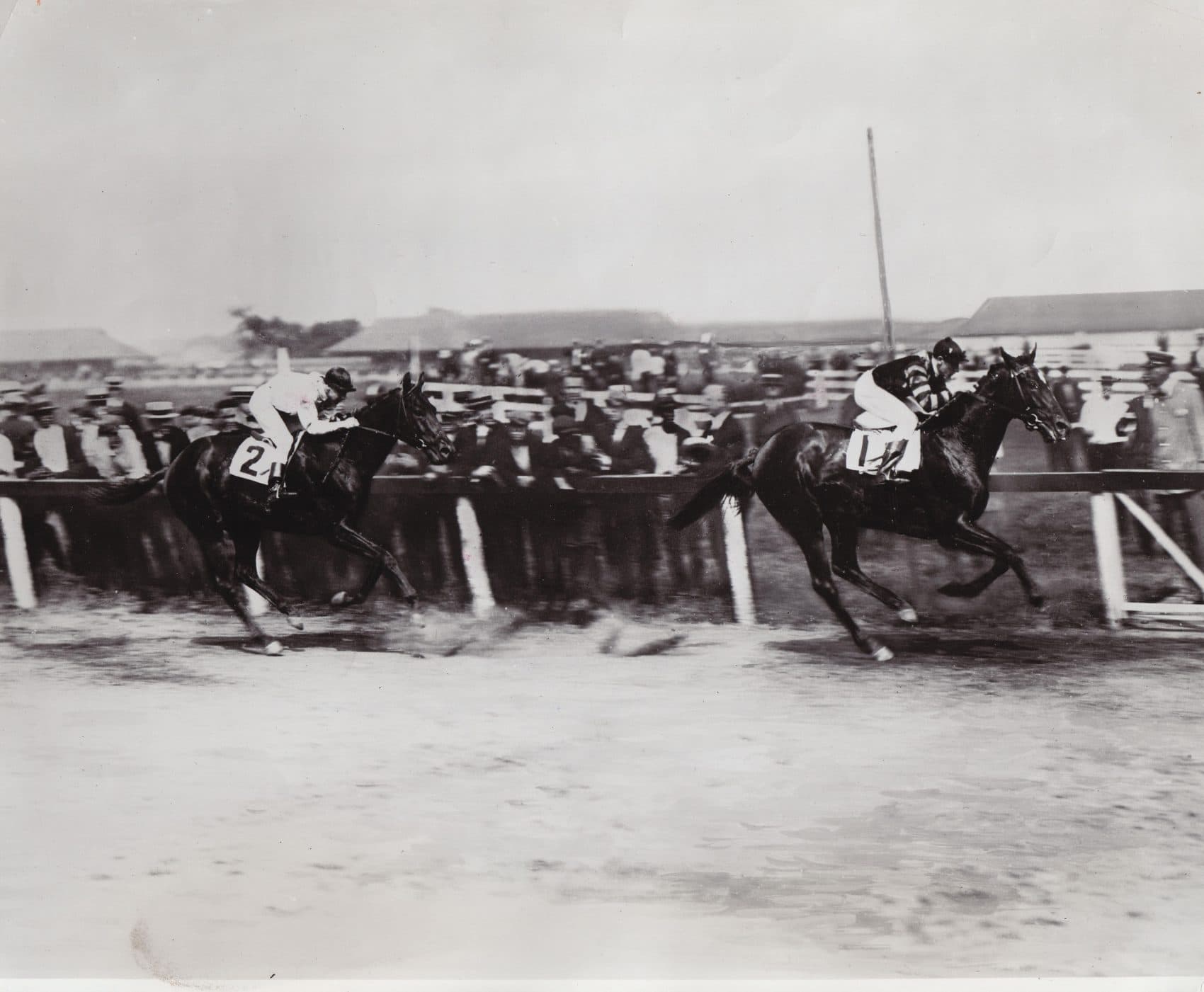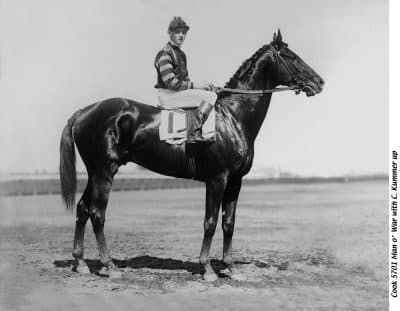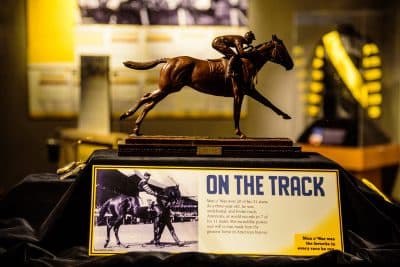Advertisement
Man O' War: A Four-Legged Legend Born 100 Years Ago
Resume
Seventy years ago, the passing of a superb champion, dead at the age of thirty, occasioned a funeral, broadcast internationally over NBC Radio on Nov. 4, 1947:
"Ladies and gentlemen, we are gathered here today to pay tribute to a great soldier. One whose influence was felt by all groups and all peoples around the world."
The athlete, born in 1917, had captured the imagination of a nation.
And he had four legs.
Man o’ War was the horse’s name. Taps was provided by a bugler from the Man o’ War Post of the American Legion in Lexington, Kentucky. As Man o’ War lay in state in a silk-lined coffin, thousands filed by to pay their respects. Why was this horse such a big deal? For the answer, you have to go all the way back to Man o’ War’s beginnings.
When the bidding began at the 1918 yearling sale in Saratoga Springs, Man o’ War looked good … but nobody recognized him as potentially great.
"There was enough interest in Man o’ War that the bidding went up to $5,000, which was by no means a record or anywhere near the top of that sale, but was still a very respectable amount for the time," says Ed Bowen, President of the Grayson Jockey Club Research Foundation and author of 20 books on horse racing.
Bowen says Man o’ War was fortunate from the beginning. The horse was purchased by a fellow who had no reason to rush him to the track.

"Samuel L. Riddle was a wonderful sportsman who had made the good judgement to marry a really wealthy lady," Bowen says. "And he had thoroughbreds as early as 1918. He truly was a horseman."
As it happened, Mr. Riddle was also a horseman who knew how to promote his horse, even before that horse had been to the track.
"Mr. Riddle indicated that the horse was almost impossible to break, and that 'no tiger ever fought harder than Man o’ War.' And, 'There was a time that I wasn’t even sure we could conquer this horse.' But probably, the reality was he was feisty and took some time to get used to having a saddle and a rider, but he was not really a terror, as far as I can tell," Bowen says.
But Man o’ War was recognized as a competitive terror shortly after his racing career began at Belmont Park on June 6th, 1919. He won his first race by six lengths, carrying 115 pounds. After another win at Belmont Park, Man o’ War won the Youthful Stakes at Jamaica Race Course, carrying an additional five pounds. Weight is added to thoroughbreds in order to handicap the faster horses and create competition. For his next six starts, the stewards further encumbered Man o’ War. He carried a total of 130 pounds. He won the first three of those races.
Then, at 6-0…
An Unlikely Upset
"The legend is that he was turned the wrong way at the start," Bowen says.
That’s a circumstance that requires explanation. When the horses lined up for the Sanford Memorial at Saratoga Race Course on August 13th, 1919, there was no starting gate. There was only barrier made of rope to hold back the field. A starter – and on this particular day it was a substitute starter – was there to pull the barrier up suddenly when the horses appeared to be ready to run. On that day, when the barrier went up, one of them wasn’t.
"He got a bad start," says Bill Cooke.
Bill Cooke is Director Emeritus of the International Museum of the Horse.
"He got boxed in next to the rail, and really had to swing wide when he made his move. And was pretty far behind at that point," Cooke says.
According to Ed Bowen, Man o’ War’s difficulties in that race were complicated by the concerted efforts of the opposition.
"After a quarter mile, he was fourth, just a length and a half behind the leaders. But then he got trapped along the rail. They didn’t let him out easily, and by the time he got out, he was charging at the end, and he failed by a half-length. He was beaten by a horse named Upset."
The result was a surprise. An upset. Such an upset, in fact, that to this day some people erroneously believe the term “upset” comes from the horse by that name.
But the loss did nothing to diminish Man o’ War’s reputation. In fact…
"The New York Times the day after the race praised the fact that Man o’ War had nearly overcome so many obstacles, and said something to the nature of, 'he was never more brilliant in victory than he was in defeat,'" Bowen says.
Perhaps that sounds like overstatement. What would the New York Times have to say today about a horse that finished second? Even a horse carrying 130 pounds?
But in Man o’ War’s day, there was no NBA. There was no NFL. Boxing and baseball were popular, but racing was just as big. And according to Bill Cooke, Man o’ War was bigger than racing:
Feasting On The Competition
"There are some horses that transcend their species — that are kind of personified as something else," Cooke says. "And I think Man o’ War fits into that category."
"In almost every race, he just got better. You know, if he didn’t set a track record or a world record or an American record, he just wasted his time that day."
Bill Cooke
The record supports Mr. Cooke. After finishing the 1919 racing season with nine firsts and that one unlikely second, Man o’ War entered the next spring’s season looking unbeatable. But, according to Ed Bowen, he didn’t enter that season as early as he might have.
"Mr. Riddle at that time thought that a mile and a quarter as early as May for a three-year-old was just pushing a young horse too fast," Bowen says. "So he just didn’t run a horse in the Kentucky Derby. And it wasn’t until mid-May that he made his 3-year-old debut in the Preakness. There were nine horses in the field. And when he won easily and had clearly come forward and gained weight and was a much more mature horse, that showed the guys that there was no hope that they were gonna sneak up on him.
Any trainer who didn’t get that message from the Preakness could have figured it out from the numbers after the horse’s next several races. On June 12, Man o’ War won the Belmont Stakes by 20 lengths.
"Yeah, he had an off day," Bowen says with a laugh.
Less than two months later, racing again at Belmont Park in the Lawrence Realization Stakes, the margin over the second place horse, Hoodwink, was…
Hey. Wait a minute. This has to be a typo.
"Well, no. That’s not a typo. Man o’ War won it by 100 lengths," Bowen says.
"I just wonder if the other horse in that race could even see Man o’ War when he crossed the finish line," I ask.
"Probably not, and it’s a question of whether Man o’ War had finished his dinner before Hoodwink finished the race," Bowen says.
"And his breakfast, as well," I say.
"Well, it was pretty phenomenal," Bill Cooke agrees. "And that was on film. You can watch it. He was just kinda trotting across the finish line. I think in his final ten races, he only faced fifteen horses. That’s some pretty small fields."
No. Those are some ridiculously small fields. They were small because Man o’ War was so dominant that most horsemen saw no point in opposing him. But Cooke says the public was enchanted
"In almost every race, he just got better," Cooke says. "You know, if he didn’t set a track record or a world record or an American record, he just wasted his time that day. You know, I think all of his last nine races, he set one kind of record or another."
'The Biggest Tourist Attraction In Kentucky'
Samuel Riddle retired Man o’ War after the 1920 racing season. The horse was three. His record: 20 wins and one second place finish. These days, owners often retire horses that have won an important race or two. The horse has more value at stud than on the track, and owners don’t like to run the risk of an injury that would eliminate the horse as a sire of future champions. But Mr. Riddle had an additional reason for retiring Man o’ War. There’s a saying in racing: “Weight will stop a train.” It means that loading a horse with enough extra weight – five pounds in one race, maybe ten or even fifteen in another - to diminish his natural advantage over the competition will hobble even a champion.
"There were estimates that he might have to carry 100 pounds," Cooke says. "And that was one reason that Sam Riddle, his owner, decided to retire him."
At which point, Man o’ War became …

"He was, for years, the biggest tourist attraction in Kentucky," Cooke says. "Bigger than Mammoth Cave. And I don’t know that that isn’t fitting. That’s kinda what we do down here."
Bill Cooke recently curated an exhibit to honor Man o’ War on the 100th anniversary of the horse’s birth. He has assembled some of the evidence of Man o’ War’s commercial impact: cigarette tins, a razor strap embroidered with the horse’s name, a jar of hair creme.
"If you had Man o’ War on there, somebody was gonna drink your whiskey or smoke your cigarettes or use your motor oil, because you knew it was gonna be good," Cooke says.
So though he didn’t know it, Man o’ War had lots of endorsements. But Ed Bowen maintains — convincingly — that the horse’s significant legacy was more great horses:
"Man o’ War got off to a tremendous start," Bowen says. "His first few years, he had 28 percent stakes winners from foals. And any time a stallion sires as many as 10 percent stakes winners, that’s really remarkable. Man o’ War crops included War Admiral, a Triple Crown winner. His daughters, many of them, produced really major race horses. He did create continuing impact right on up ‘til today. And it will carry on."
So it will … as long as there is thoroughbred racing.
This segment aired on June 9, 2017.
